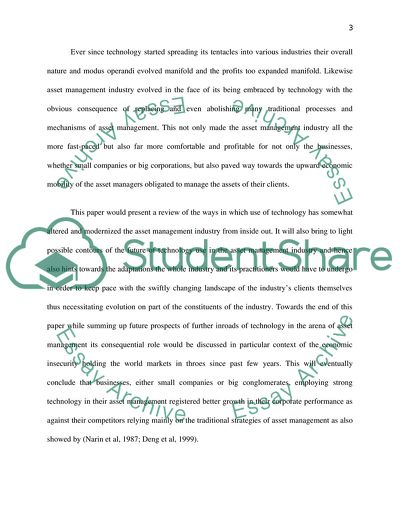Cite this document
(The Role of Technology in Asset Management Industry Coursework Example | Topics and Well Written Essays - 3000 words, n.d.)
The Role of Technology in Asset Management Industry Coursework Example | Topics and Well Written Essays - 3000 words. https://studentshare.org/finance-accounting/1870263-contemporary-asset-management-in-a-boutique-and-a-conglomerate-essay-title-what-is-the-role-of-technology-in-the-asset-management-industry-and-what-is-the-implication-of-its-advancement-for-the-industrys-future
The Role of Technology in Asset Management Industry Coursework Example | Topics and Well Written Essays - 3000 words. https://studentshare.org/finance-accounting/1870263-contemporary-asset-management-in-a-boutique-and-a-conglomerate-essay-title-what-is-the-role-of-technology-in-the-asset-management-industry-and-what-is-the-implication-of-its-advancement-for-the-industrys-future
(The Role of Technology in Asset Management Industry Coursework Example | Topics and Well Written Essays - 3000 Words)
The Role of Technology in Asset Management Industry Coursework Example | Topics and Well Written Essays - 3000 Words. https://studentshare.org/finance-accounting/1870263-contemporary-asset-management-in-a-boutique-and-a-conglomerate-essay-title-what-is-the-role-of-technology-in-the-asset-management-industry-and-what-is-the-implication-of-its-advancement-for-the-industrys-future.
The Role of Technology in Asset Management Industry Coursework Example | Topics and Well Written Essays - 3000 Words. https://studentshare.org/finance-accounting/1870263-contemporary-asset-management-in-a-boutique-and-a-conglomerate-essay-title-what-is-the-role-of-technology-in-the-asset-management-industry-and-what-is-the-implication-of-its-advancement-for-the-industrys-future.
“The Role of Technology in Asset Management Industry Coursework Example | Topics and Well Written Essays - 3000 Words”. https://studentshare.org/finance-accounting/1870263-contemporary-asset-management-in-a-boutique-and-a-conglomerate-essay-title-what-is-the-role-of-technology-in-the-asset-management-industry-and-what-is-the-implication-of-its-advancement-for-the-industrys-future.


